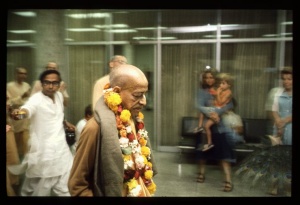SB 7.7.18

A.C. Bhaktivedanta Swami Prabhupada
TEXT 18
- janmādyāḥ ṣaḍ ime bhāvā
- dṛṣṭā dehasya nātmanaḥ
- phalānām iva vṛkṣasya
- kāleneśvara-mūrtinā
SYNONYMS
janma-ādyāḥ—beginning with birth; ṣaṭ—the six (birth, existence, growth, transformation, dwindling and at last death); ime—all these; bhāvāḥ—different conditions of the body; dṛṣṭāḥ—seen; dehasya—of the body; na—not; ātmanaḥ—of the soul; phalānām—of the fruits; iva—like; vṛkṣasya—of a tree; kālena—in due course of time; īśvara-mūrtinā—whose form is the ability to transform or control the bodily activities.
TRANSLATION
Just as the fruits and flowers of a tree in due course of time undergo six changes—birth, existence, growth, transformation, dwindling and then death—the material body, which is obtained by the spirit soul under different circumstances, undergoes similar changes. However, there are no such changes for the spirit soul.
PURPORT
This is a very important verse in understanding the difference between the spiritual soul and the material body. The soul is eternal, as stated in Bhagavad-gītā (BG 2.20):
- na jāyate mriyate vā kadācin
- nāyaṁ bhūtvā bhavitā vā na bhūyaḥ
- ajo nityaḥ śāśvato 'yaṁ purāṇo
- na hanyate hanyamāne śarīre
"For the soul there is never birth nor death. Nor, having once been, does he ever cease to be. He is unborn, eternal, ever-existing, undying and primeval. He is not slain when the body is slain." The spirit soul is eternal, being freed from waste and change, which take place because of the material body. The example of a tree and its fruits and flowers is very simple and clear. A tree stands for many, many years, but with the seasonal changes its fruits and flowers undergo six transformations. The foolish theory of modern chemists that life can be produced by chemical interactions cannot be accepted as truth. The birth of a human being's material body takes place due to a mixture of the ovum and semen, but the history of birth is that although the ovum and semen mix together after sex, there is not always pregnancy. Unless the soul enters the mixture, there is no possibility of pregnancy, but when the soul takes shelter of the mixture the body takes birth, exists, grows, transforms and dwindles, and ultimately it is vanquished. The fruits and flowers of a tree seasonally come and go, but the tree continues to stand. Similarly, the transmigrating soul accepts various bodies, which undergo six transformations, but the soul remains permanently the same (ajo nityaḥ śāśvato 'yaṁ purāṇo na hanyate hanyamāne śarīre (BG 2.20)). The soul is eternal and ever existing, but the bodies accepted by the soul are changing.
There are two kinds of soul—the Supreme Soul (the Personality of Godhead) and the individual soul (the living entity). As various bodily changes take place in the individual soul, different millenniums of creation take place in the Supreme Soul. In this regard, Madhvācārya says:
- ṣaḍ vikārāḥ śarīrasya
- na viṣṇos tad-gatasya
- ca tad-adhīnaṁ śarīraṁ ca
- jñātvā tan mamatāṁ tyajet
Since the body is the external feature of the soul, the soul is not dependent on the body; rather, the body is dependent on the soul. One who understands this truth should not be very much anxious about the maintenance of his body. There is no possibility of maintaining the body permanently or eternally. Antavanta ime dehā nityasyoktāḥ śarīriṇaḥ. This is the statement of Bhagavad-gītā (BG 2.18). The material body is antavat (perishable), but the soul within the body is eternal (nityasyoktāḥ śarīriṇaḥ). Lord Viṣṇu and the individual souls, who are part and parcel of Him, are both eternal. Nityo nityānāṁ cetanaś cetanānām (Kaṭha Upaniṣad 2.2.13). Lord Viṣṇu is the chief living being, whereas the individual living entities are parts of Lord Viṣṇu. All the various grades of bodies—from the gigantic universal body to the small body of an ant—are perishable, but the Supersoul and the soul, being equal in quality, both exist eternally. This is further explained in the next verses.